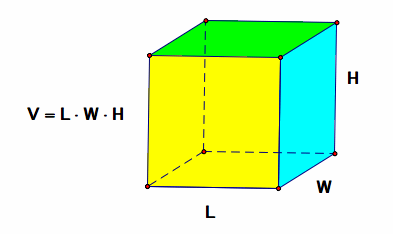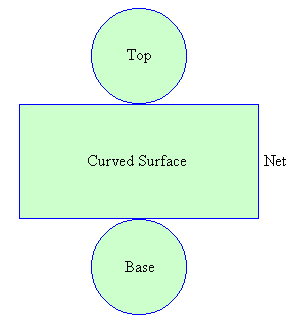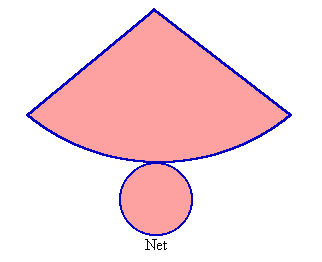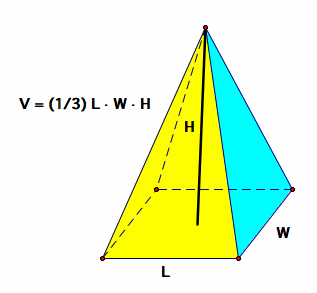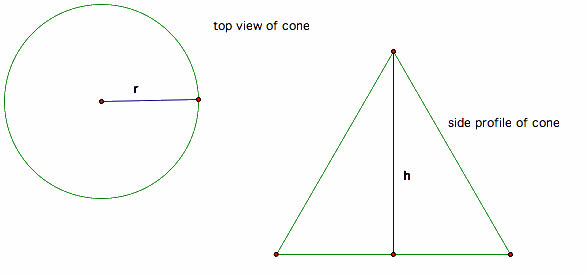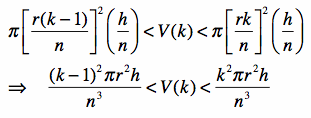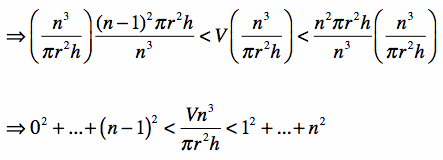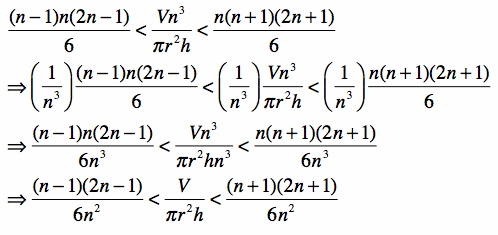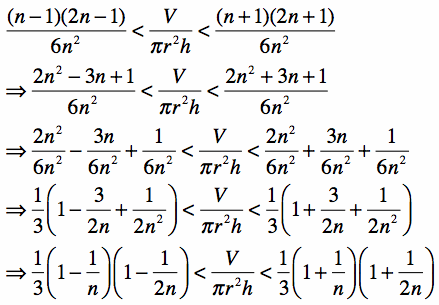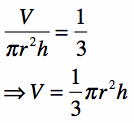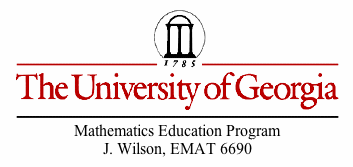
Comparing the Volumes of Two Three-Dimensional Objects
by
Mike Rosonet
"Mr. Allen's Geometry class is studying volume this week. Today, his class is learning about the volume of a right cylinder and the volume of a right cone. When he placed the two formulas for volume side-by-side, his most inquisitive student, Eleanor, asked, 'Mr. Allen, the only thing that's different between those two formulas is the fraction 1/3. How do they know that the volume of a cone is 1/3 of the volume of a cylinder?'"
Commentary
Many teachers have faced similar scenarios where one student will ask the question that the teacher was hoping no one would ask. Typically, the question is either, "Why?" or "How?" Unfortunately, too many teachers do not have the resources available to them to be able to answer either of these questions; oftentimes, it is not due to the lack of funds found within a school or a school system. It is the lack of education that a teacher has in their background. In order to answer this question, a teacher will obviously need to know the definition of volume and the formulas for the volume of a right cone and a right cylinder. However, an extension to this that a teacher may need to be prepared for involves the formulas for the volume of a cube and a right pyramid, as a similar issue is found between these two three-dimensional objects. A teacher would also need to know mathematical induction in order to complete a proof that will show why the volume of a cone is 1/3 of the volume of a cylinder. Lastly, a teacher would greatly help their students by providing them with a visual example or activity showing them that the volume of a cone is one-third the volume of a cylinder.
What is volume?
According to Wolfram Mathworld, the volume of a solid object is defined as "the amount of 'space' [the solid object] occupies" (Weisstein, 2010). It is measured in cubed length units of measure. For example, the volume of a cube is the product of the lengths of its length, width, and height, expressed as
Notice that the formula for the volume of a cube is the area of the base of the cube multiplied by the height of the cube. Hence, the volume of any 3-D object whose height meets its base at a right angle could be given as the product of the area of the base of the object multiplied by the height of the object.
The volume of a right cylinder
The following is a net of a right cylinder. (A net is a pattern of developing a polyhedron.) By folding the net properly, a person could construct a 3-D model of a right cylinder.
The formula for the volume of a right cylinder is the number pi multiplied by the radius of the circle at the base of the cylinder squared multiplied by the height of the cylinder.
As mentioned above, with any right 3-D figure, the volume equals the product of the area of the base multiplied by the height of the object.
Since the formula for the area of a circle is
,
the volume of a right cylinder equals the product of the area of the circle at its base and the height of the cylinder.
The volume of a right cone
The following is a net of a right cone. By folding the net properly, a person could construct a 3-D model of a right cone.
The formula for the volume of a right cone is (1/3) multiplied by the number pi multiplied by the radius of the circle at the base of the cone squared multiplied by the height of the cone.
As with the volume of a right cylinder, the volume of a right cone equals the product of (1/3) of the area of the circle at its base and the height of the cone.
From the formulas for the volume of a right cylinder with height h and the volume of a right cone with height h, it is easy to see that the volume of a cone is (1/3) of the volume of a cylinder, given that they have equal heights. Conversely, the volume of the cylinder is three times the volume of a cone if they are on equal circle bases and have the same height.
Extension
Similar to the right cylinder versus the right cone, the formula for the volume of a cube and the formula of the volume of a right square pyramid differ only by the fraction (1/3). Recalling the figure of the cube above,
As depicted, the formula for the volume of a cube equals the product of the length and width of the base and the height of the cube.
As depicted in this figure, the formula for the volume of a pyramid equals the product of (1/3) of the length and width of the base and the height of the pyramid.
From the two formulas, it is plain to see that, if a cube and a pyramid have equal bases with equal lengths and widths, and have equal heights, then the volume of the pyramid will be (1/3) of the volume of the cube. Conversely, the volume of the cube will be three times the volume of the pyramid.
Proof
Now that it's been shown through comparing the formulas, it is necessary to prove that the volume of a right cone with height h and radius r is (1/3) that of the volume of a right cylinder with height h and radius r.
Given a cone of height h, slice the cone into n pieces with (n-1) equally-spaced planes that are parallel to one another and are parallel to the base of the cone. Each of these pieces is a frustum of the given cone. (A frustum is any piece of a solid object that lies between two parallel planes that cut the object.)
An image of the kth frustum of a cone with height h
This is a cross-section of frustum ABCD. There is also a cross-section of a smaller cylinder, which would be AFJD with radius LD; and there is a cross-section of a larger cylinder, which would be EBCG with radius MC. The segment LM is a segment of the height of the given cone as well as a segment of the heights of the two cylinders; the height of all 3 objects is h. The length of segment LM = (h/n) = (the total height of the cone/the number of pieces of the cone).
As seen in the image, the volume of the frustum ABCD is greater than the volume of the cylinder AFJD whose radius is equal to the radius of the smaller base of the frustum. Also, the volume of frustum ABCD is less than the volume of the cylinder EBCG whose radius is equal to the radius of the larger base of the frustum. This is because the smaller cylinder AFJD is contained within the frustum ABCD, which itself is contained within the cylinder EBCG.
For this kth piece from the top of the cone, that is depicted in the above image,
and
.
Therefore, if the volume of the kth frustum is V(k), then the following inequality holds true:
Adding up these inequalities for k = 1, 2, 3, ..., n will give the volume of the cone as V = V(1) +...+ V(k-1) + V(k)...+ V(n).
Divide both sides of the inequality by
and multiply by
:
At this point in the proof, it is necessary that the teacher have an understanding of mathematical induction, which says that the sum of the first n squares is
;
hence, the sum of the first (n-1) squares is
.
Therefore, substitute these sums into the inequality:
Divide both sides by
:
At this point in the mathematics, multiply the binomials in each numerator and divide each of the resulting terms by the denominator. Then, factor out (1/3) and factor the remaining polynomial:
Recall that n could be any positive integer and that the above inequalities are true. As n increases, the quantity on the left and the quantity on the right both approach a value of (1/3). The difference between the two quantities is just (1/n). As n increases in value, this difference between these two quantities approaches zero. Furthermore, if the quantity on the left needed to be larger than (1/3) - a, for some real number a > 0, choose n > 1/(2a); if the quantity on the right needs to be less than (1/3) + a, choose n > 1/(3a).
Therefore, for any positive real number a, it holds true that
Since the only real number x that satisfies the condition (1/3) - a < x < (1/3) + a for every real number a, x must be equal to the number (1/3). Thus,
Therefore, the volume of a right cone with height h and radius r is (1/3) of the volume of a right cylinder with height h and radius r.
Similarly, this proof can be used, with small variation, to prove that a right pyramid whose base and height are both equal to the base and height of a right parallelpiped has a volume that is equal to one-third of the volume of the parallelpiped.
Visual Example
Here is an activity that students can perform in order to see that the volume of a cone is (1/3) the volume of a cylinder, given that they have equal heights and are on equal bases.
Needed materials:
- a paper cup (cone shape)
- a beaker of equal height and opening
- water or sand (something to measure in the cup and beaker)
The cup and the beaker must have equal heights and have equal openings. Measure the diameter of each to check, or trace them on paper and measure the diameters of the traces.
Have students fill up the beaker using the cup.
Student Observations: (have students list them in a free space on their "lab" sheet or on their own paper)
Questions to ask: (pose them on the back of the "lab" sheet or on the board or ask them of the class aloud)
- How many full cups did you require to fill up the beaker?
- If you were to empty the contents of the beaker into cups, how many cups would you need?
- What is the formula for the volume of a cylinder?
- What is the formula for the volume of a cone?
- If the heights are the same and the openings/bases are the same, how many times greater is the volume of a cylinder compared with the volume of a cone?
The purpose of the activity is to allow students the opportunity to investigate the volume of a cylinder and the volume of a cone using manipulatives and to draw their own conclusions. Ideally, the teacher would not need to pose all of the above questions due to the observations listed by the students.
** This activity could also be used for cubes and pyramids, if the teacher had those manipulatives to use as well or in place of the cylinder and cone. **
References
Rehill, G. S. (2010). "Cones and cylinders." Year 8 interactive maths - second edition. Retrieved from http://www.mathsteacher.com.au/year8/ch10_geomcons/09_cones/cylinder.htm
Weisstein, E. W. (2010). Volume. Retrieved from http://mathworld.wolfram.com/Volume.html
